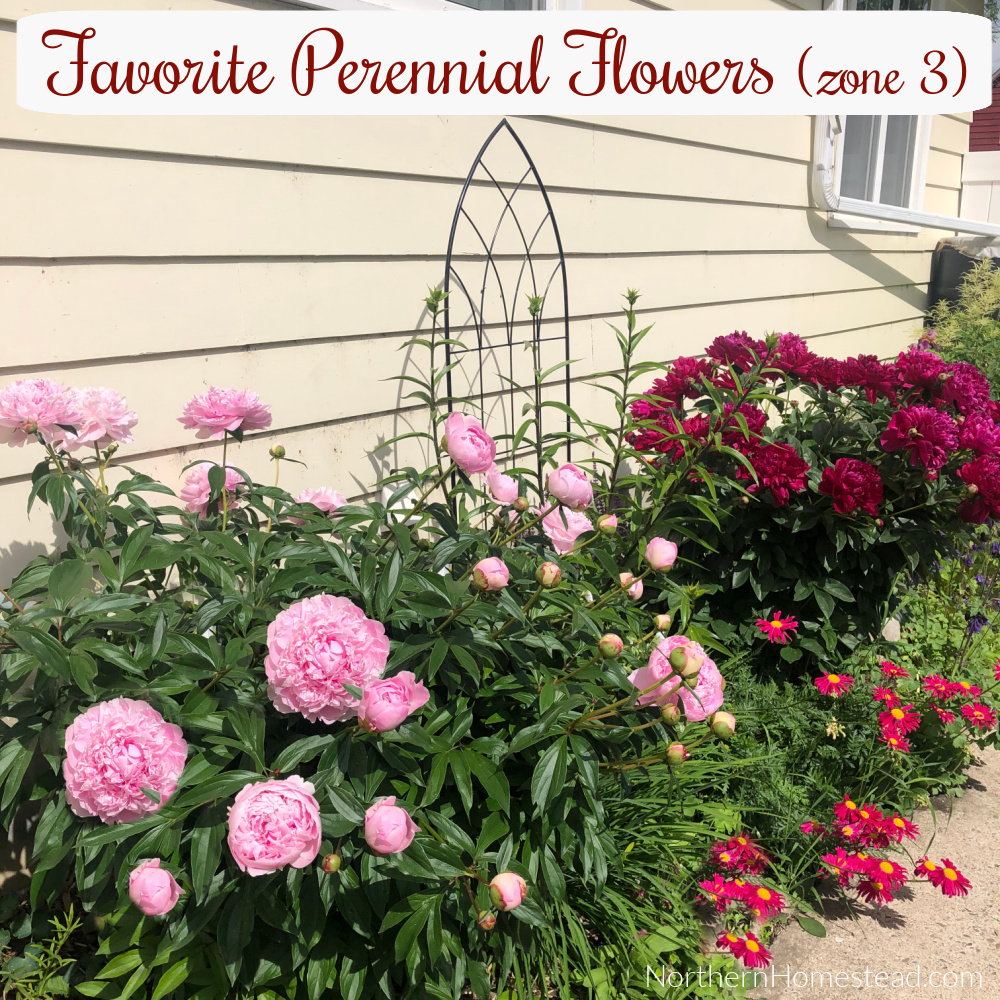
Even though we focus on growing food, the perennial flower favorites in our northern garden bring us a lot of joy. Many beautiful and hardy perennial flowers grow well in zone 3. With a little love and care you can enjoy an abundance of flowers all season long.

Perennials are planted once and enjoyed for many years. Our garden had already a huge collection of perennial flowers when we bought the house. The previous owner saved the tags and handed them over to us. We felt like we had been given a very special treasure. Over the years we added more to the collection.
Here we share our favorite perennial flowers and how we care for them without spending much time or effort.
Why grow perennial flowers
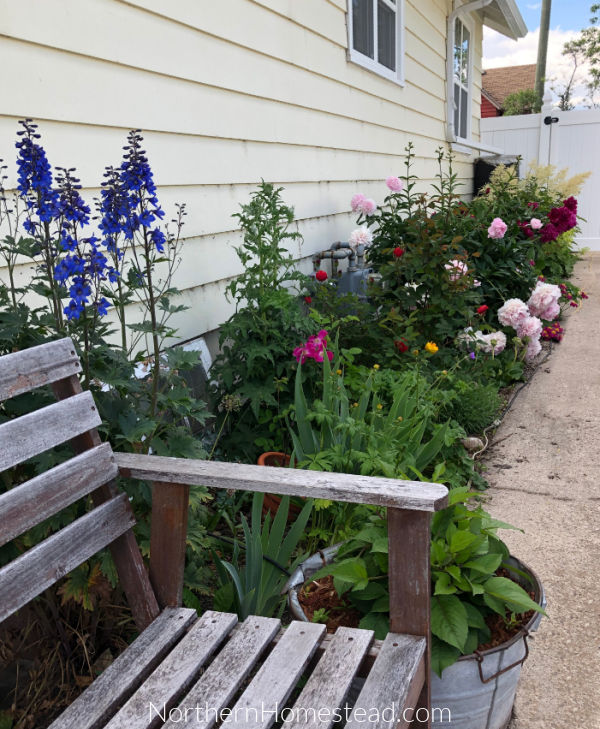
Perennial flowers are a great choice for any area on the property that is not suitable for food production. Areas that are shady, dry, have poor soil, etc, can all be planted with perennial flowers. There is a flower for about any situation.
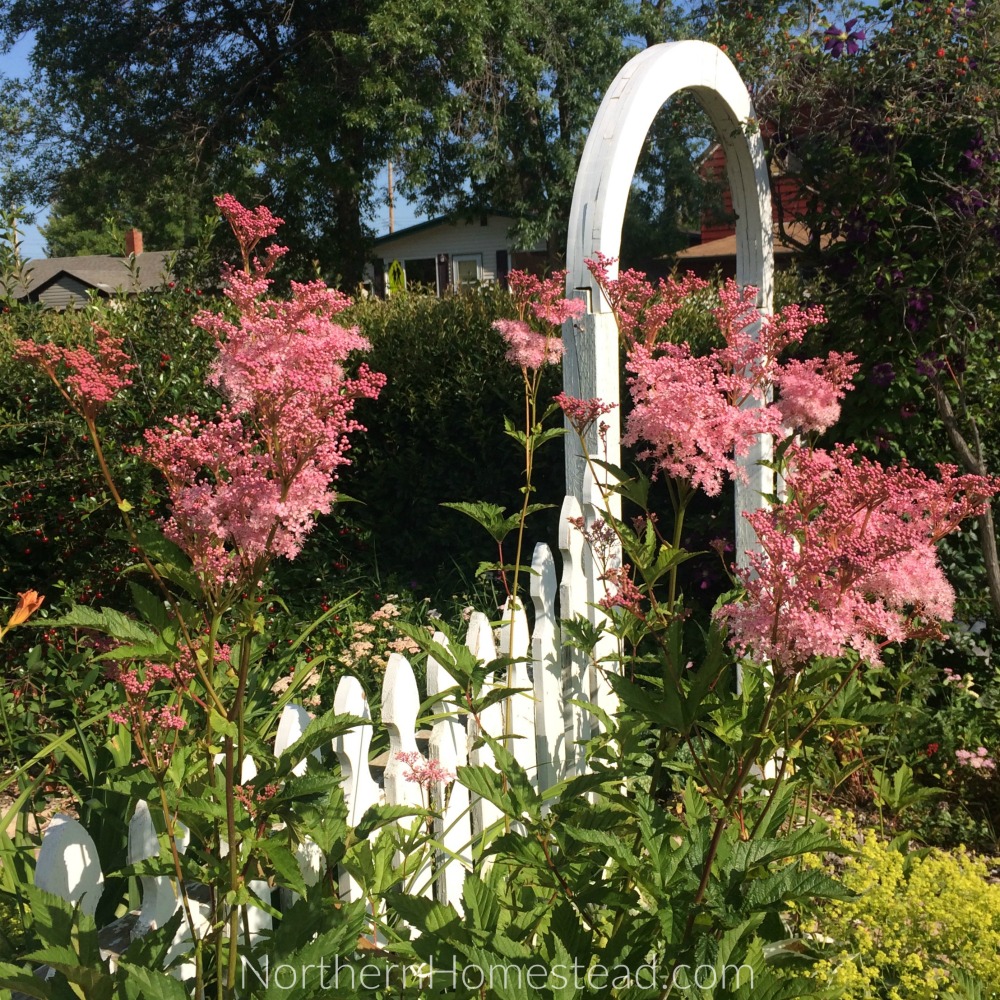
Creeping flowers or ground covers can be planted instead of lawn. They need less care and are beneficial for insects. We turned our yard into a garden, there is no lawn here.

Perennials tend to come up much earlier than annuals. After a long winter, seeing their little heads pop up under the snow is priceless.
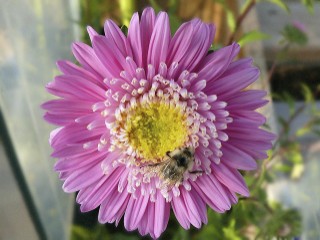
Flowers attract beneficial insects and pollinators. We need them, to give them more food and living space is important.
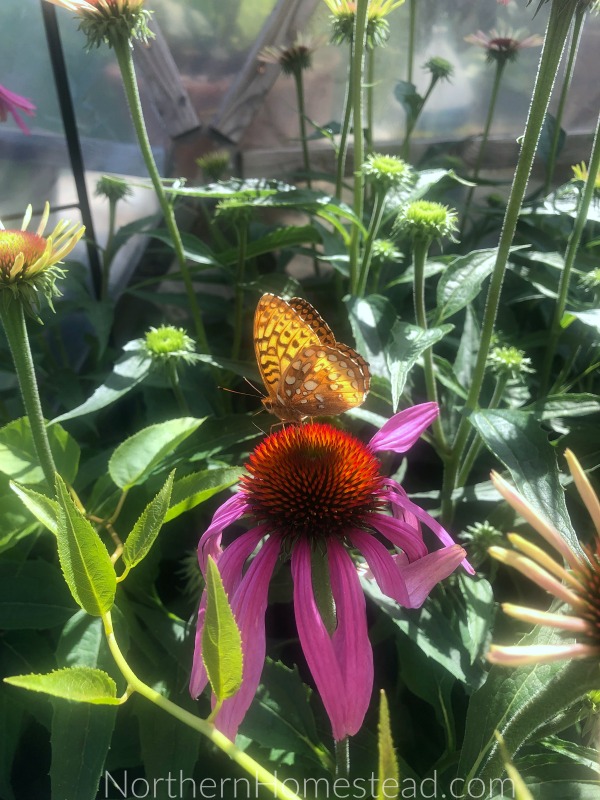
Caring for perennial flowers
Perennials do need care too, but not as much as annuals. Here we share how we care for our perennial flower garden. As you know, we like things simple, if that is true in a vegetable garden, and it is, it’s even more true in a flower garden.
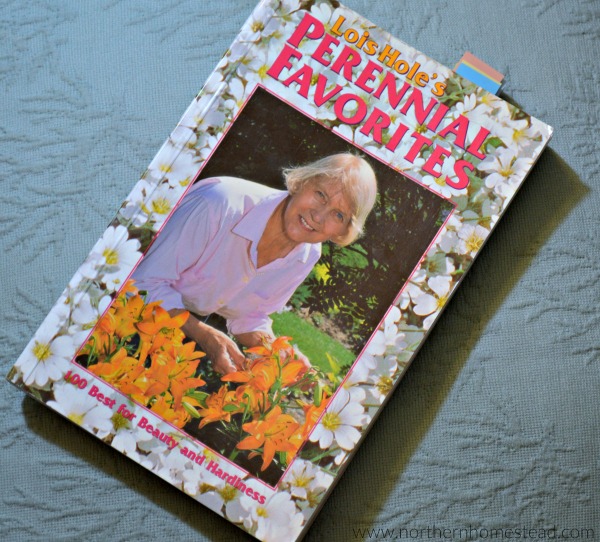
First, let me share with you my favorite book: Perennials Favorites by Lois Hole. Lois Hole has left us a real treasure in this practical book. She lists 100 of her favorite perennial plants, chosen for their beauty and hardiness. A lot of her favorites are also growing in our garden. I’ve bookmarked them all for easy finding and for learning what we have grown.
I use that book all the time. There is no one-fits-all approach, to be able to look up each plant and see what it needs, and how to care for it is so helpful. If you are into growing hardy perennial flowers, get yourself that book. Now that we have got that covered, let’s continue with what we do to care for the perennial flower garden in general.
Spring care
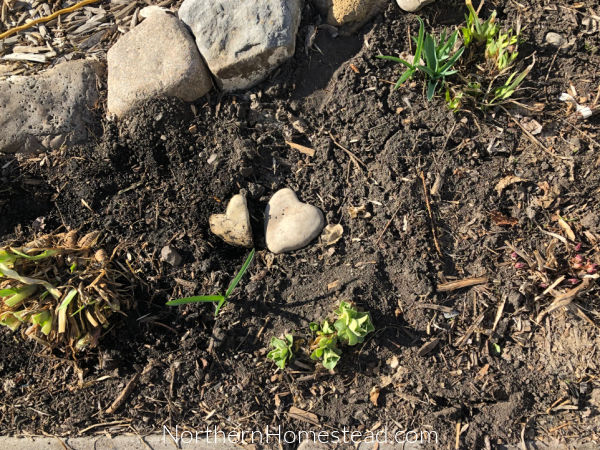
In our garden, perennial flowers are the first ones that get attention in early spring. Since our garden has many microclimates, the snow and ground melt in different areas at different times. This gives me a longer window to work on my flowers. It also gives me something to do in the garden, before the vegetable garden starts.
Since we do not clean up in the fall (see below), the first thing we do is cut back the old stems. Often many insects are hiding in them. If it is too early for them to fly away, we gather them in a pile, allowing the bugs to hide a bit longer before cleaning it all up. Don’t compost or throw out anything until later in the year. Just get it out of the way so the new growth can sprout.
I do not clean thoroughly, I also do not dig or hoe the soil. Instead, we add some new mulch, usually woodchips, to cover the soil. The left leaves and the new mulch improve the soil year after year.
Early spring is also the time when it is easy to see if a plant needs dividing or a new place to grow. We talk about dividing later.
When to apply the mulch?
Mulch plays a key role in our easy-care garden. Fortunately, we have a free source of wood chips mulch from a tree care company. Ask around in your area, tree care companies often have lots of wood chips that are not suited for sale (The twigs and leaves stuff), and they might be willing to give it to you.
We apply the mulch in two different ways, depending on the area and what is planted.
Usually, once all of the plants are up and growing, we lay a thick layer around each plant to prevent weeds from growing.
But we also cover the whole area with a few inches of mulch in areas where we grow mostly ground cover. This can be done in fall or early spring before the plants start growing. We do not do this every year, ground covers don’t seem to need it.
Summer care
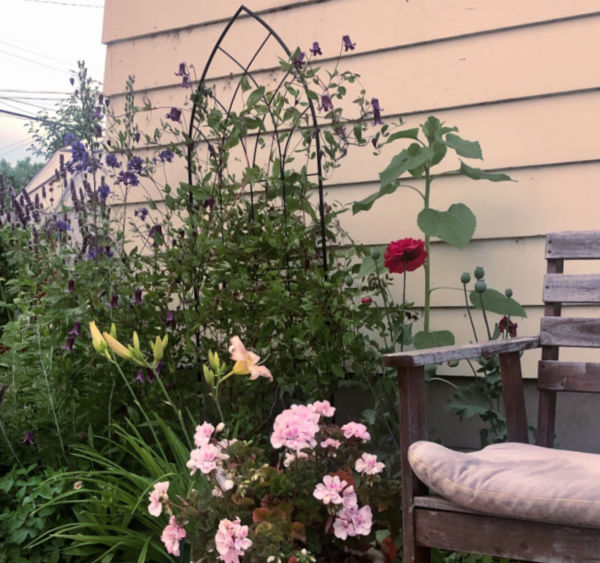
During the summer our perennial plants are really on their own. We just enjoy them.
The mulch takes care of most of the weeding and watering.
Deadheading flowers is only done as needed. Once the flower heads have turned to seeds, it is important to cut them back, unless you want to reseed them all.
Fall care
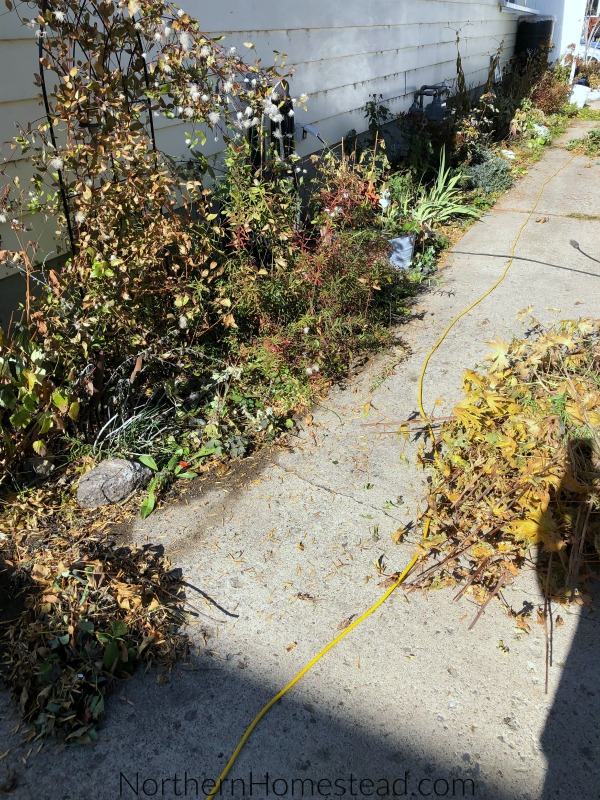
Since most of our perennial flowers grow along pathways and the driveway, we clean them in the fall with snow removal in mind. What is in the way gets cut back, everything else is left as is.
Even if the perennial plants are hardy they appreciate a snow cover during hard winter frost. If you can’t assure a snow cover, mulch them with leaves in the fall to avoid winter kill. This often happens naturally, when the wind brings in leaves and piles them up around the stems.
Do not clean up so much, so you will not have to cover so much and the plants stay healthier. It also gives the beneficial insects a place to hide and overwinter.
Not so hardy perennial flowers
Most of our perennial flowers are hardy to at least zone 3. However, there are a few favorites, that we just have to grow, even though they are not hardy.
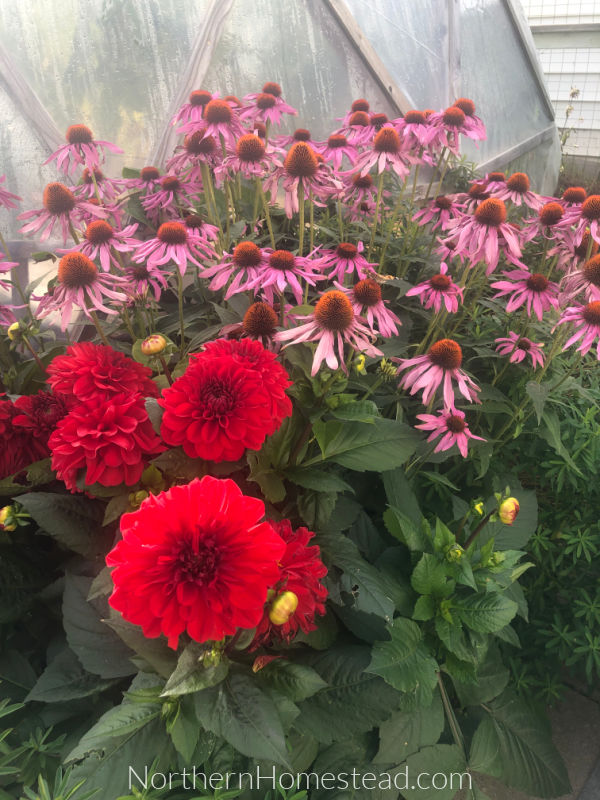
Dahlias remind me of my sister, they are a must-have for me. They of course are not hardy enough for our climate. We start them in a container in the greenhouse about a month before the last frost. When the danger of frost is over, we transplant them into the garden. In the fall, we leave them till, after the frost and dig them up and store them in woodshavings in the cold room.
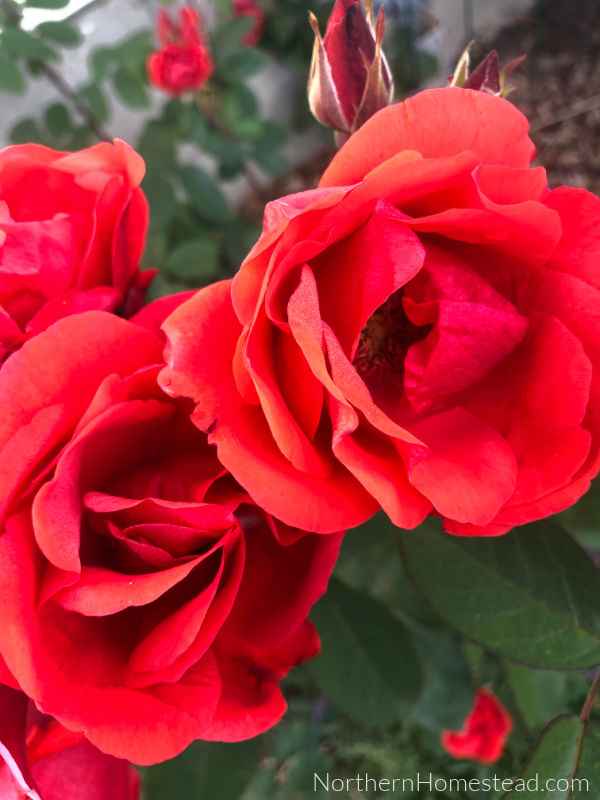
Ornamental roses may or may not be hardy. To be sure, we always cover with leaves during the winter. We also make sure there is snow piled up on the plant as well.
Dividing perennials
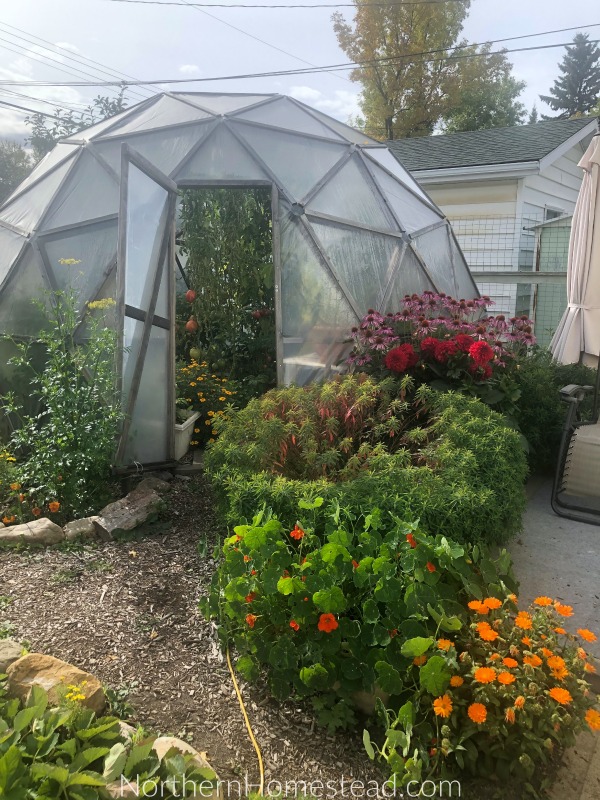
Most perennials need to be divided, some every 3 years, others will be fine up to 5 years and some can be left alone for 10 or more years. Dividing perennials will rejuvenate them and also give you more beautiful perennial to plant elsewhere.
Whenever you see a plant that is overcrowded and/or has a weak center it’s time to divide it. If you wait longer the plant will stop blooming and actually becomes smaller in size because some of the overgrown plants will die.
Usually, I look up the particular plant that needs attention in my book Perennials Favorites.
Spring is the best time to divide most perennial plants. Wait till the ground is not frozen any longer and the plant has about 1-2 inches of new growth. Lift out the entire plant and then divide it into 2-3 pieces (discard the dead center). Make sure each piece has a growing point (if it is a large plant leave at least 3 stems) and lots of roots.
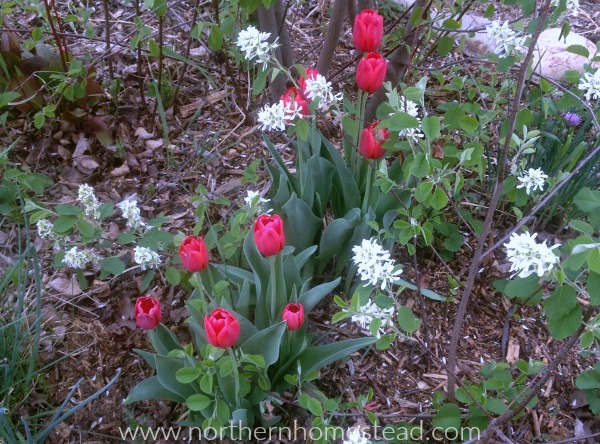
Spring flowers, like tulips, are better divided or transplanted after they have finished flowering and start to go dormant.
Depending on the size of the plant and what kind of roots or bulbs they have, you can divide them with your hands by pulling the plant apart, or cut with a knife, or even with a shovel. Whatever you do try to work gently, you do not want to kill the plant, just to divide it.
Plant one piece back into the original hole by adding some compost or potting soil. A handful of bone meal fertilizer can be helpful too. Also, you want to plant perennials firmly into the soil. Treat that plant as a new transplant for a while. It will need more water than a perennial plant usually does.
Keep your subdivided plants moist, till you find a new home for them.
Perennial favorites in bloom
It is a real joy month after month to see all those beautiful flowers and to enjoy them. I’m so grateful so many flowers do survive our cold winters here in zone 3.
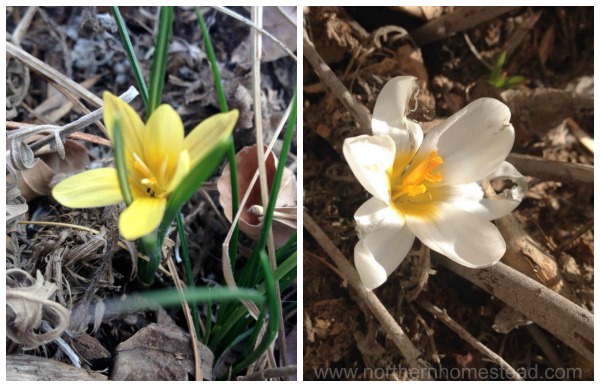
First flowers in our garden usually pop up in March, telling us that spring is here. They may be a bit early and look weather-beaten, but never the less, we welcome them very much.
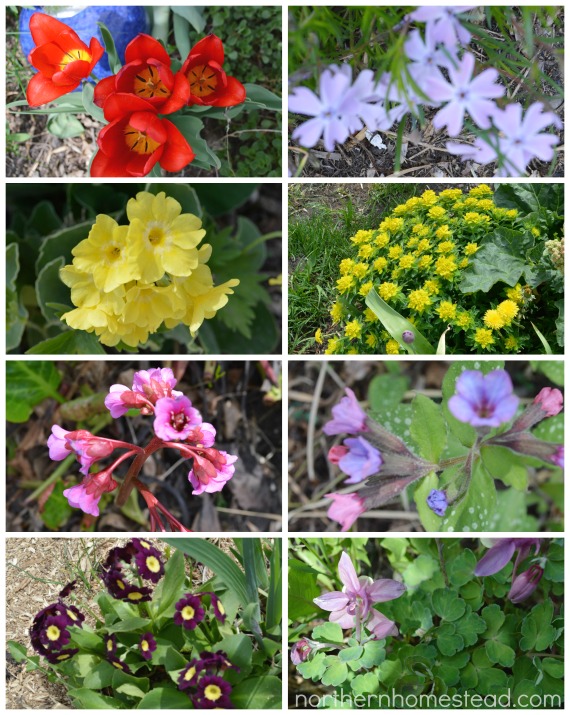
After that, spring flowers just keep coming in all shapes and colors. Blooming are Elephant-ears, Primrose, Spurge, Pulmonaria.
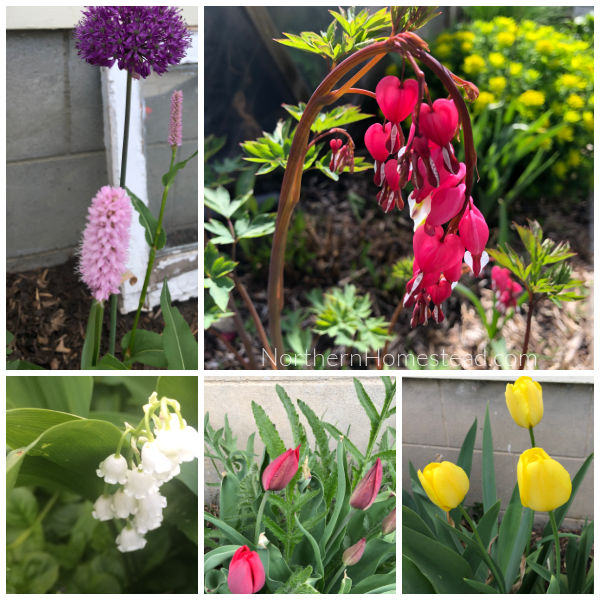 By May our perennial flower garden is in full bloom. Bleeding heart, Tulips, ornamental onion, lily-of-the-Valley.
By May our perennial flower garden is in full bloom. Bleeding heart, Tulips, ornamental onion, lily-of-the-Valley.
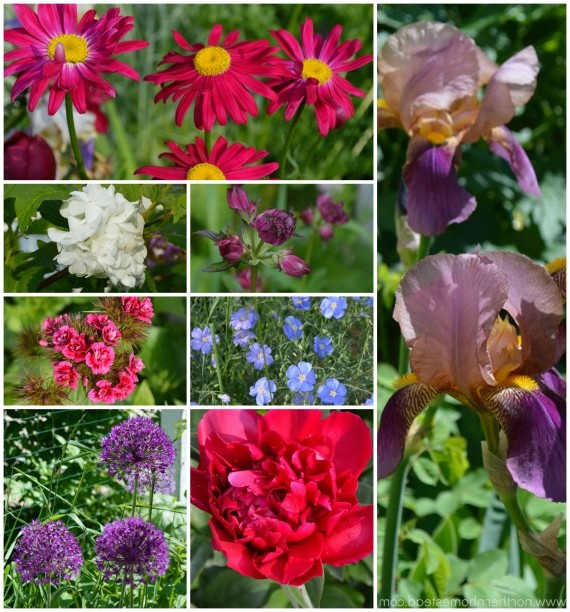
In June the colors just get brighter and the flowers get bigger. It might just be the best month for perennial flowers. Blooming are Flax, Iris, Masterwort, Ornamental Onion, Painted Daisy, Peony, Pink, (Not in picture: Jakob’s Ladder, Sea Holly, St. John’s Wort, Yarrow.)
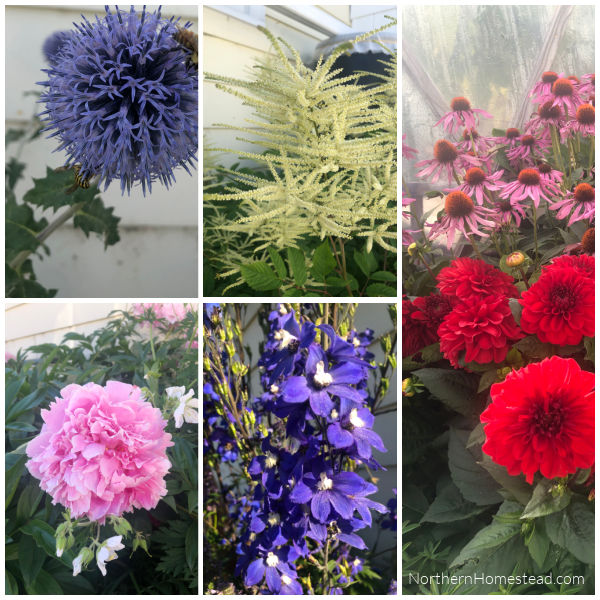
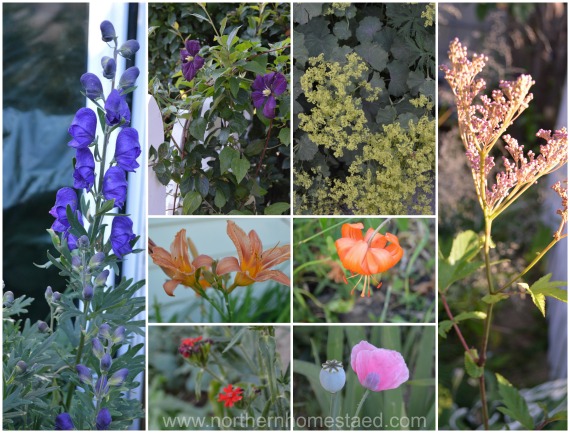
July continues the magic, butterflies, and hummingbirds are making their rounds. It’s bliss for all. Blooming are Campion, Clematis, Daylily, Delphinium, Lady’s Mantle, Lily, Meadowsweet, Poppy, Glob thistle, Goatsbeard.
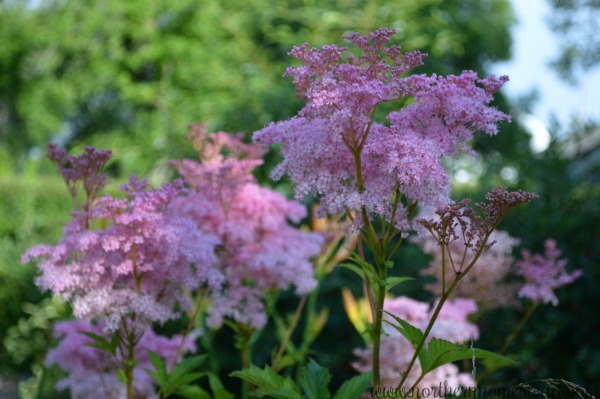
Meadowsweet needs a special mention, this is the Queen-of-the-Prairie variety, one of the showiest perennials.
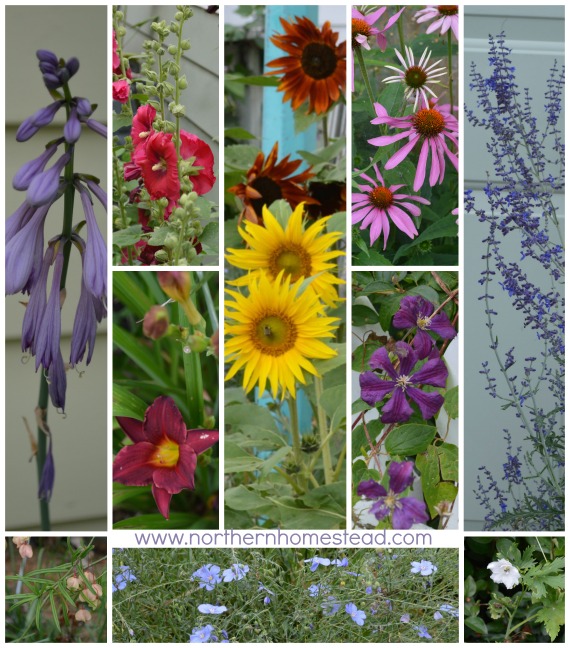
By August, annuals join the perennials in a harmony of colors, shapes, and beauty. Blooming are Snowdrop anemones, Coneflower, Clematis, Daylily, Flax, Hollyhock, Hosta, Russian Sage.
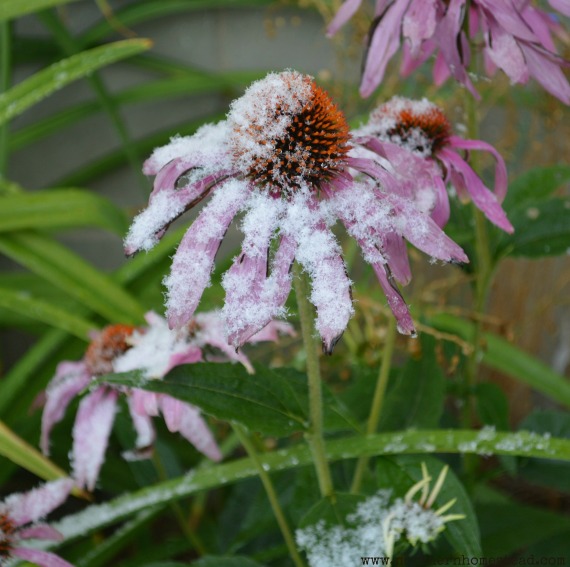
Many flowers bloom all summer long till snow and frost end their blooming in a bit of a brutal but pretty way.
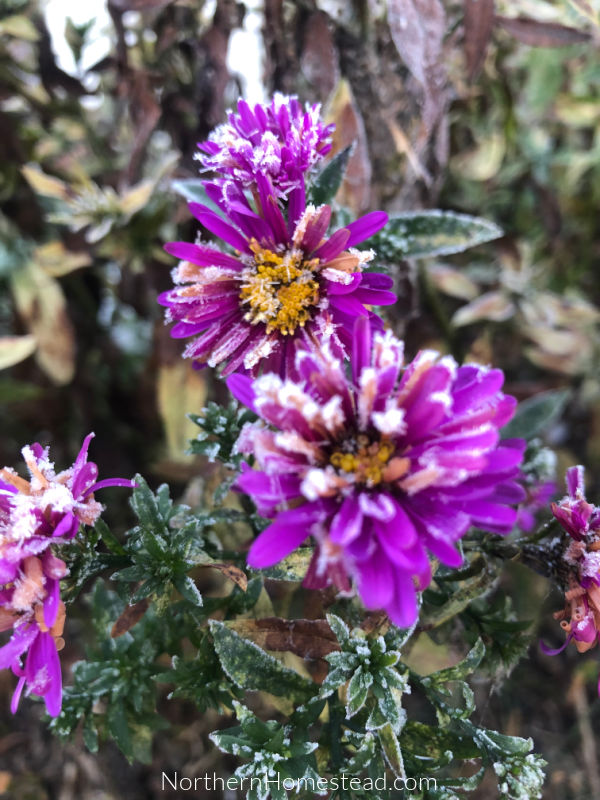
But still, until late October something is blooming here for us. We love all the flowers and look forward to starting the blooming year all over again. Blooming is Italian asters violet and pink.
What is blooming in your garden? Do you also find books helpful for caring for all those flowers?
We invite you to subscribe to Northern Homestead and follow us on Facebook, Instagram, or Pinterest for the latest updates.



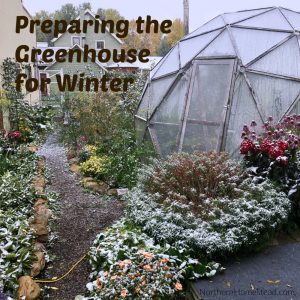
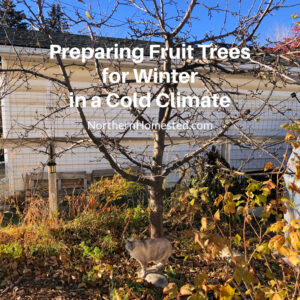
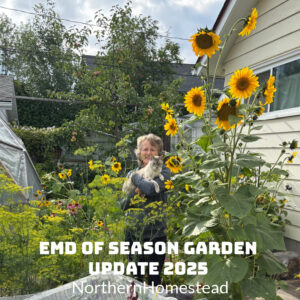
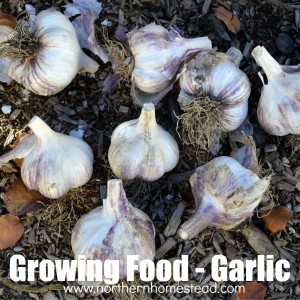
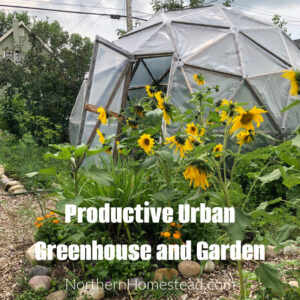
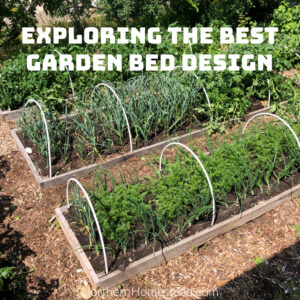
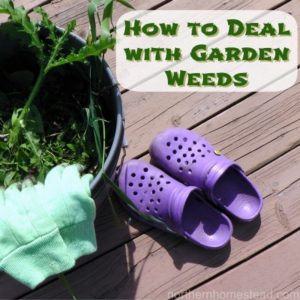
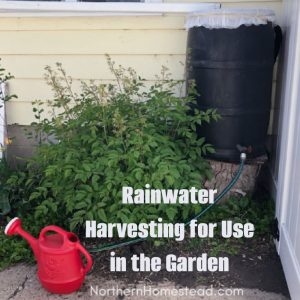
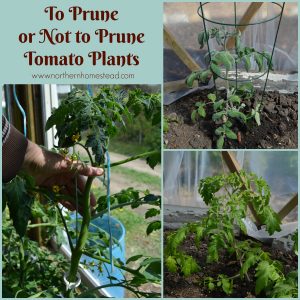

Oh No! Your missing one! Bleeding Heart. I’m especially fond of one that I keep in a big red glazed pot in the shaded area under my porch…the blooms are white as snow!
You are very attentive and right, Bleeding Heart was missing in my flower garden. So guess what I did, I got one. It is still adjusting to its new location, but I hope that it will be in full bloom next spring. A white Bleeding Heart in a red pot must be gorgeous.
Your pictures are wonderful and give me hope. We live in Ontario, zone 5 (which is not bad) with lots of trees and shade. For the last few years the squirrels have eaten all the buds off flowers before they had a chance to bloom … Though they do leave the mint, sage and onions alone there is usually not much left of the vegetable garden when they get through with it. I got so frustrated that I actually pulled up all my half eaten tulips even though I used to love seeing them in the spring. Suggestions?
So sorry Christl, I feel your pain. Squirrels are after our sunflowers, and also love the early greens we plant. To have a cat in the garden helps a bit, so they do not come closer to the house and leave the garden mostly alone. You can try to make a hot pepper spray and spray the plants where the squirrels come first. It should turn them off and does not harm the plants.